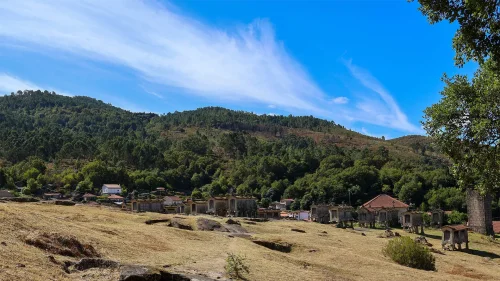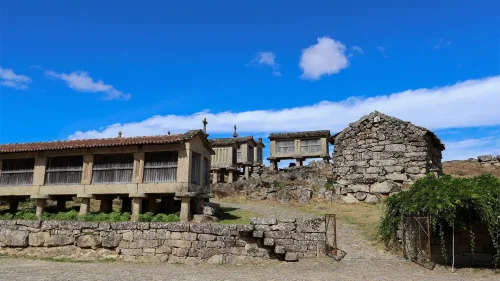Lindoso Granaries
Learn more about the Lindoso granaries.
The Granaries of Lindoso
In the heart of Alto Minho, between verdant valleys and imposing granite outcrops, stands Lindoso, a village whose identity is intertwined with its medieval castle and, above all, its granaries. Located in the Peneda-Gerês National Park, these stone granaries comprise one of the most remarkable collections of Portuguese folk architecture and are today one of the greatest symbols of the country's rural heritage.
Between History and Landscape
Lindoso Castle, built in the 13th century and expanded by King Dinis, still preserves the memory of the battles that defined the borders between Portugal and the Kingdom of Castile. But, next to the fortress, the real surprise for visitors is a sea of granaries that extends across the communal threshing floor, as if it were a village within a village. More than sixty structures line the grounds overlooking the Lima River, in perfect harmony with the rocky landscape that surrounds them.
The Granaries of Lindoso
The concentration of Granaries of Gerês
What are Granaries?
Granaries are traditional buildings used for storing and preserving corn, introduced into Portugal in the 16th century. In Lindoso, they are mostly made of granite, built on pillars topped with circular stones called "torna-ratos," which prevent animals from accessing them. The walls have vertical gaps that allow ventilation, ensuring the drying and preservation of the grain.
Dating back to the 17th and 19th centuries, many of these granaries display crosses and other religious symbols carved into the stone. These ornaments were not merely decorative: they were believed to spiritually protect the crops. This fusion of functionality and religiosity makes them unique pieces of rural architecture.
A Photogenic Treasure
With over 120 granaries scattered throughout the parish, approximately 60 of which are concentrated near the castle, Lindoso boasts the largest collection of this architectural style in the entire Iberian Peninsula. It's no surprise, then, that it's one of the most photographed spots in Gerês. The contrast between the stone buildings, the green landscape, and the imposing fortress creates a scene that seems suspended in time.
Community Symbol
Beyond their practical function, Lindoso's granaries reflect the community spirit of the local population. Grouped around a communal threshing floor, they were shared and used jointly, much like other infrastructure such as washhouses or ovens. This organizational model reinforced social cohesion and solidarity among neighbors, central elements of life in mountain villages.
Visit Lindoso
Exploring Lindoso is like immersing yourself in tradition and nature. Besides the granaries and castle, the village offers other points of interest, such as the main church, crosses, the medieval Santiago Bridge, and even traces of rock art. More adventurous visitors will also find several hiking trails that traverse the Serra Amarela and reveal the unspoiled beauty of the Peneda-Gerês National Park.
In summary, espigueiros represent an essential part of Portugal's agricultural and cultural legacy. With their unique architecture and historical significance, these structures continue to enchant and preserve the memory of rural communities, highlighting the importance of the past and the richness of tradition in the present.





